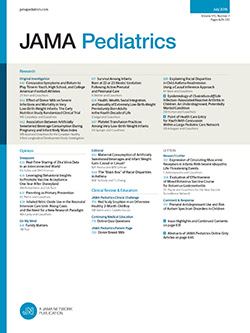Prenatal Cannabis Use and Neonatal Outcomes
IF 24.7
1区 医学
Q1 PEDIATRICS
引用次数: 0
Abstract
ImportancePrenatal cannabis use continues to increase, and cannabis remains the most commonly used illegal substance in pregnancy. Accumulating evidence suggests potential adverse effects on fetal and neonatal outcomes following cannabis use in pregnancy.ObjectiveTo update a living systematic review and meta-analysis to provide a timely understanding regarding cannabis use in pregnancy and fetal and neonatal outcomes.Data SourcesThe previous review was updated by searching bibliographic databases MEDLINE, CINAHL, PsycInfo, Global Health, and Evidence-Based Medicine Reviews Cochrane Database of Systematic Reviews from November 1, 2021, through April 4, 2024.Study SelectionCohort or case-control studies comparing pregnancies with and without prenatal cannabis use on prespecified fetal or neonatal outcomes with adjustment for confounders, such as co-use of tobacco products, were included. Two independent reviewers screened studies, with disagreements resolved through discussion.Data Extraction and SynthesisIncluded studies were extracted by 1 reviewer and confirmed by a second. Risk of bias was assessed with the Newcastle-Ottawa Scale. Random-effects meta-analyses of unadjusted and adjusted odds ratios (ORs) were performed for all primary outcomes. Results were synthesized using the Grading of Recommendations Assessment, Development, and Evaluation approach.Main Outcomes and MeasuresPrimary outcomes were preterm birth (PTB; <37 weeks of gestation), small for gestational age (SGA), low birth weight (LBW; <2500 g), and perinatal mortality.ResultsFor this update, 8 new studies with 1 709 998 participants were added, for a total of 51 studies synthesized (N = 21 146 938). From meta-analyses of adjusted effect sizes, moderate-certainty evidence indicated that cannabis use in pregnancy was associated with increased odds of LBW (20 studies; OR, 1.75; 95% CI, 1.41-2.18), PTB (20 studies; OR, 1.52; 95% CI, 1.26-1.83), and SGA (12 studies; OR, 1.57; 95% CI, 1.36-1.81), and low-certainty evidence indicated that it was associated with greater odds of perinatal mortality (6 studies; OR, 1.29; 95% CI, 1.07-1.55). Previously, the evidence was rated as very low or low certainty.Conclusions and RelevanceCannabis use in pregnancy was associated with greater odds of PTB, SGA, and LBW even after adjusting for co-use of tobacco products, and confidence in these findings increased from low in the prior review to moderate in the current meta-analysis. The findings of this study may help inform patient counseling and future public health policies.产前大麻使用和新生儿结局
产前大麻的使用继续增加,大麻仍然是怀孕期间最常用的非法物质。越来越多的证据表明,怀孕期间使用大麻对胎儿和新生儿的结局有潜在的不利影响。目的更新一项实时系统综述和荟萃分析,以及时了解大麻使用对妊娠和胎儿及新生儿结局的影响。数据来源通过检索文献数据库MEDLINE、CINAHL、PsycInfo、Global Health和循证医学综述Cochrane系统评价数据库,从2021年11月1日至2024年4月4日更新先前的综述。研究选择纳入了队列或病例对照研究,比较了产前是否使用大麻对预先规定的胎儿或新生儿结局的影响,并调整了混杂因素,如共同使用烟草制品。两名独立评审员对研究进行筛选,并通过讨论解决分歧。资料提取和综合纳入的研究由一位审稿人提取,并由另一位审稿人确认。偏倚风险采用纽卡斯尔-渥太华量表进行评估。对所有主要结果进行了未调整和调整优势比(or)的随机效应荟萃分析。采用建议分级、评估、发展和评价方法对结果进行综合。主要结局和测量方法主要结局为早产(PTB;孕37周),小于胎龄(SGA),低出生体重(LBW;& lt;2500 g),以及围产期死亡率。本次更新纳入8项新研究,共纳入1 709 998名受试者,共纳入51项研究(N = 21 146 938)。从调整效应量的荟萃分析中,中等确定性的证据表明,怀孕期间使用大麻与LBW的几率增加有关(20项研究;或者,1.75;95% CI, 1.41-2.18), PTB(20项研究;或者,1.52;95% CI, 1.26-1.83)和SGA(12项研究;或者,1.57;95% CI, 1.36-1.81),低确定性证据表明,它与围产期死亡率更高的几率相关(6项研究;或者,1.29;95% ci, 1.07-1.55)。以前,证据被评为非常低或低确定性。结论和相关性:即使在调整了共同使用烟草制品的因素后,妊娠期使用大麻与PTB、SGA和LBW的风险增加有关,并且在当前的荟萃分析中,对这些发现的信心从先前综述中的低增加到中等。本研究的发现可能有助于为患者咨询和未来的公共卫生政策提供信息。
本文章由计算机程序翻译,如有差异,请以英文原文为准。
求助全文
约1分钟内获得全文
求助全文
来源期刊

JAMA Pediatrics
PEDIATRICS-
CiteScore
31.60
自引率
1.90%
发文量
357
期刊介绍:
JAMA Pediatrics, the oldest continuously published pediatric journal in the US since 1911, is an international peer-reviewed publication and a part of the JAMA Network. Published weekly online and in 12 issues annually, it garners over 8.4 million article views and downloads yearly. All research articles become freely accessible online after 12 months without any author fees, and through the WHO's HINARI program, the online version is accessible to institutions in developing countries.
With a focus on advancing the health of infants, children, and adolescents, JAMA Pediatrics serves as a platform for discussing crucial issues and policies in child and adolescent health care. Leveraging the latest technology, it ensures timely access to information for its readers worldwide.
 求助内容:
求助内容: 应助结果提醒方式:
应助结果提醒方式:


